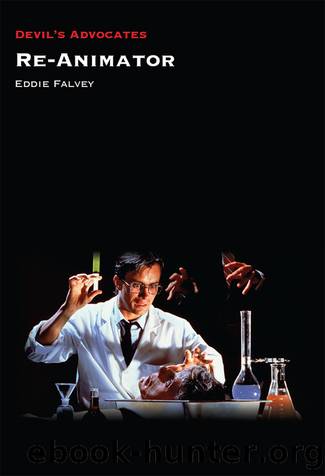Re-Animator by Eddie Falvey;

Author:Eddie Falvey; [Неизв.]
Language: eng
Format: epub
Publisher: Oxford University Press USA
Lovecraftian Adaptation in the Films of Stuart Gordon
Returning to a case I made in chapter one, it is fair to argue that Re-Animator is about as strong a film as Charles Bandâs Empire International Pictures ever did make. It is also reasonable, I would suggest, to propose that Stuart Gordon was the best technical filmmaker working within the studio at any time during its run. Indeed, Linda Badley has argued for Gordonâs status as a âhorror auteurâ, by which she is referring to âthe large number of notable recent directors whose films are recognized as employing, throughout a body of work, horror film syntax and themes to express, often self-reflexively and âsubversively,â their âvisionsââ (2004: 224-5). Listing Gordon beside other notable horror auteurs including Dario Argento, Clive Barker, Mario Bava, Tim Burton, John Carpenter, Wes Craven, David Cronenberg, Larry Cohen, Brian De Palma, Abel Ferrara, Lucio Fulci, Tobe Hooper, David Lynch, Roman Polanski, Sam Raimi, Jean Rollin, George Romero and Ken Russell, Badley makes a case for, firstly, unstitching any existing critical distinctions between âhighâ and âlowâ forms of horror (ie. Polanskiâs highbrow literariness beside Rollinâs sex-fuelled exploitation films), as well as a case for marking Gordon out as a filmmaker with an overriding âvisionâ to speak of.
This vision is well worth scrutinising in the context of Gordonâs ongoing interest in the works of Lovecraft, represented by adaptations over a twenty-year period: From Beyond, Castle Freak, Dagon and Dreams in the Witch House, a TV movie that featured as part of Mick Garrisâs Masters of Horror series (2005-7), a series that was for some critics important for determining auteur status among contemporary horror filmmakers.45 Joe Hickinbottom, in a chapter on Takashi Miikeâs horror reputation, makes use of Garrisâs Masters of Horror as a prism through which to observe the discursive and economic functions of the horror auteur, and how such statuses are conferred and capitalised upon. Hickinbottom writes that âMasters of Horror was accordingly billed as an opportunity for audiences to indulge in the nightmarish work of some of horror cinemaâs greatest directorsâ (2020: 95). While Gordonâs status as a horror master is less contentious than, say, Miikeâs,46 it nevertheless invigorates a way of looking at the directorâs work that invites one to situate it within the principle tenets of auteurism.
Joe Tompkins has identified how important the idea of the auteur is to the marketing of horror. In his assessment of horror auteurism and the splat pack â referring to a group of popular âtorture pornâ filmmakers such as Eli Roth, James Wan and Rob Zombie who all emerged in the early twenty-first century â Tompkins claims the following:
[A]uteurism remains central to the marketing of some horror films. The invocation of horror auteurs has tended to permit critics, fans, and filmmakers to accumulate subcultural capital by expressing their appreciation of, and affiliation with, ultraviolent horror. What is more, this practice has become part of industry practice, with production and distribution personnel seeking to invest themselves and their output with the subcultural authenticity that is associated with a cohort of 1970s horror directors.
Download
This site does not store any files on its server. We only index and link to content provided by other sites. Please contact the content providers to delete copyright contents if any and email us, we'll remove relevant links or contents immediately.
The Kite Runner by Khaled Hosseini(4948)
Gerald's Game by Stephen King(4369)
Dialogue by Robert McKee(4156)
The Perils of Being Moderately Famous by Soha Ali Khan(4064)
Story: Substance, Structure, Style and the Principles of Screenwriting by Robert McKee(3326)
The 101 Dalmatians by Dodie Smith(3296)
The Pixar Touch by David A. Price(3203)
Confessions of a Video Vixen by Karrine Steffans(3098)
How Music Works by David Byrne(2959)
Fantastic Beasts: The Crimes of Grindelwald by J. K. Rowling(2837)
Harry Potter 4 - Harry Potter and The Goblet of Fire by J.K.Rowling(2797)
Slugfest by Reed Tucker(2796)
The Mental Game of Writing: How to Overcome Obstacles, Stay Creative and Productive, and Free Your Mind for Success by James Scott Bell(2763)
4 - Harry Potter and the Goblet of Fire by J.K. Rowling(2527)
Screenplay: The Foundations of Screenwriting by Syd Field(2430)
Scandals of Classic Hollywood: Sex, Deviance, and Drama from the Golden Age of American Cinema by Anne Helen Petersen(2392)
Wildflower by Drew Barrymore(2378)
The Complete H. P. Lovecraft Reader by H.P. Lovecraft(2366)
Casting Might-Have-Beens: A Film by Film Directory of Actors Considered for Roles Given to Others by Mell Eila(2302)
